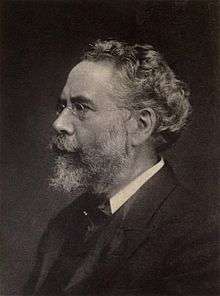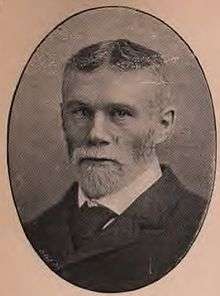Glasgow Bridgeton (UK Parliament constituency)
Glasgow Bridgeton was a parliamentary constituency in the city of Glasgow. From 1885 to 1974, it returned one Member of Parliament (MP) to the House of Commons of the Parliament of the United Kingdom, elected by the first-past-the-post voting system.
For many years it was represented by James Maxton, the leader of the Independent Labour Party whose policies were to the left of the Labour Party.
Boundaries
The Redistribution of Seats Act 1885 provided that the constituency was to consist of the first and fourth Municipal Wards.[2]
The constituency was described in the Glasgow Parliamentary Divisions Act 1896 as being-
- "The area within a line beginning at a point in the centre of Albert Bridge, where the same intersects the centre line of the River Clyde, and thence proceeding eastwards along the centre of that river till it meets the parliamentary boundary of the city at Harvie's Dyke; thence northwards along the said parliamentary boundary to the centre of London Road; thence westwards along the centres of London Road and Canning Street to a point opposite the centre of Clyde Street; thence northwards along the centres of Clyde Street and Abercromby Street to the centre of Gallowgate; thence westwards along the centre of Gallowgate to a point opposite the centre of Saltmarket; thence southwards along the centre of Saltmarket to the centre of the River Clyde at the point first described."
In the Representation of the People Act 1918 it was described as-
- "That portion of the city which is bounded by a line commencing at a point on the centre line of London Road, where the road is crossed by the Caledonian Railway (Glasgow Lines), thence south-westward and southward along the centre line of the said railway to where it joins the Caledonian Railway Branch Line from Dalmarnock to Rutherglen, thence southward along the centre line of the said last-mentioned railway to a point on the municipal boundary at the centre line of the River Clyde, thence south-westward and north-westward along the municipal boundary of the city to a point on the centre line of the River Clyde about 77 yards south-eastward from the centre of Rutherglen Bridge, thence westward, northward and westward along the centre line of the River Clyde to the centre of Albert Bridge thence northward along the centre line of Saltmarket to the centre line of Gallowgate, thence eastward along the centre line of Gallowgate to the centre line of Abercromby Street, thence southwestward along the centre line of Abercromby Street to the centre line of Canning Street, thence eastward along the centre line of Canning Street and London Road to the point of commencement."
The Representation of the People Act 1948 provided that the constituency was to consist of the Calton and Dalmarnock wards of the City of Glasgow. The Parliamentary Constituencies (Scotland) (Glasgow Bridgeton, Glasgow Provan and Glasgow Shettleston) Order, 1955 [3] added to this the portion of the Mile-End ward that had previously been part of the Glasgow Camlachie constituency.
The Parliamentary Constituencies (Scotland) Order 1970[4] provided that the constituency was to consist of "The following wards of the county of the city of Glasgow, namely, Calton and Dalmarnock and that part of Mile-End ward which lies to the west of a line commencing at a point on the northern boundary of the ward immediately opposite the centre line of Millerston Street; thence southward to and along the centre line of Millerston Street to the centre line of Gallowgate; thence eastward along the centre line of Gallowgate to a point opposite the centre line of Fielden Street; thence southward along the centre line of Fielden Street to the termination of the line on the southern boundary of the Mile-End ward opposite the centre of Fielden Street."
Members of Parliament
Election results
Elections in the 1880s

E.R. Russell

Trevelyan
Elections in the 1890s
Having accepted office as Secretary for Scotland, George Otto Trevelyan was returned unopposed at Glasgow Bridgeton by-election, 1892.[7]

Trevelyan
Elections in the 1900s

James Cleland
Elections in the 1910s

James Maxton
- Unionist candidate William Hutchison withdrew when Coalition Government endorsed the Liberal candidate
Elections in the 1920s
Elections in the 1930s
Elections in the 1940s
Elections in the 1950s
Elections in the 1960s
Elections in the 1970s
Notes
- ↑ Statutory Instrument 1970 No. 1680 (section Two) The Parliamentary Constituencies (Scotland) Order 1970 (Coming into force 25 November 1970)
- ↑ Redistribution of Seats Act 1885, Sixth Schedule
- ↑ Statutory Instrument 1995/23
- ↑ S.I. 1970/1680.
- ↑ James Carmichael was elected in 1946 as an Independent Labour Party candidate. However, he and the two other ILP MPs defected to the Labour Party in 1947.
- 1 2 3 Debrett's House of Commons and Judicial Bench, 1889
- 1 2 Whitaker's Almanack, 1893
- 1 2 3 Debrett's House of Commons and the Judicial Bench, 1901
- ↑ Whitaker's Almanack, 1907
- 1 2 Debrett's House of Commons and Judicial Bench, 1916
- ↑ Whitaker's Almanack, 1920
- 1 2 3 The Constitutional Year Book, 1930
- ↑ The Constitutional Year Book, 1932
- ↑ Whitaker's Almanack, 1934
- ↑ Whitaker's Almanack, 1939
- ↑ The Times, 17 Nov 1961
- ↑ Kimber, Richard. "UK General Election results 1964". Political Science Resources. Retrieved 11 April 2016.
- ↑ Kimber, Richard. "UK General Election results 1966". Political Science Resources. Retrieved 11 April 2016.
- ↑ Kimber, Richard. "UK General Election results 1970". Political Science Resources. Retrieved 11 April 2016.
References
|
|---|
|
|
|
|
|
- Aberdeen North
- Aberdeen South
- Airdrie & Shotts
- Angus
- Argyll & Bute
- Ayr, Carrick & Cumnock
- Banff & Buchan
- Berwickshire, Roxburgh & Selkirk
- Caithness, Sutherland & Easter Ross
- Central Ayrshire
- Coatbridge, Chryston & Bellshill
- Cumbernauld, Kilsyth & Kirkintilloch East
- Dumfries & Galloway
- Dumfriesshire, Clydesdale & Tweeddale
- Dundee East
- Dundee West
- Dunfermline & West Fife
- East Dunbartonshire
- East Kilbride, Strathaven & Lesmahagow
- East Lothian
- East Renfrewshire
- Edinburgh East
- Edinburgh North & Leith
- Edinburgh South
- Edinburgh South West
- Edinburgh West
- Falkirk
- Glasgow Central
- Glasgow East
- Glasgow North
- Glasgow North East
- Glasgow North West
- Glasgow South
- Glasgow South West
- Glenrothes
- Gordon
- Inverclyde
- Inverness, Nairn, Badenoch & Strathspey
- Kilmarnock & Loudoun
- Kirkcaldy & Cowdenbeath
- Lanark & Hamilton East
- Linlithgow & East Falkirk
- Livingston
- Midlothian
- Moray
- Motherwell & Wishaw
- Na h-Eileanan an Iar
- North Ayrshire & Arran
- North East Fife
- Ochil & South Perthshire
- Orkney & Shetland
- Paisley & Renfrewshire North
- Paisley & Renfrewshire South
- Perth & North Perthshire
- Ross, Skye & Lochaber
- Rutherglen & Hamilton West
- Stirling
- West Aberdeenshire & Kincardine
- West Dunbartonshire
|




